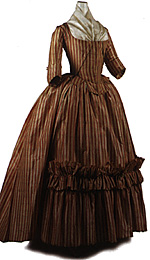
"A lady's leg is a dangerous sight, in whatever colour it appears;
but, when it is enclosed in white, it makes an irresistible attack upon us."
--The Universal Spectator, 1737
The Costume Institute of The Metropolitan Museum of Art in New York City has an exhibition running until 18 August, 1996 called "Bare Witness: Clothing and Nudity" which explores costume in its dual role as both concealer and revealer of the female body. The exhibition displays the changing history of fashion in the 18th, 19th and 20th centuries, focusing on the shifting erogenous zones and equally mobile cultural values. From floor length gowns that exposed the breasts in the 1780's, to topless bathing suits and miniskirts in the 1960's and 1970's, women's fashion has been one of the barometers of society's progress.
The following excerpts are from the catalog published in conjunction with the exhibit. They are reprinted here, along with the photograph, with the permission of The Metropolitan Museum of Art, Richard Martin, Curator. A copy of the catalog can be purchased by sending $9.95 plus $4.50 for shipping and handling payable to The Metropolitan Museum of Art, Attention: Book Shop, 1000 Fifth Avenue, New York, NY 10028-0198 USA. Credit card orders are taken at (212) 650-2911. (Note: The museum has stores in California, Colorado, Connecticut, Georgia, New Jersey, New York, Ohio, and Texas. Sales tax must be added for orders from these states.)
 The photograph shows a robe a l'anglaise from the 1785-1787 period. This was more simple and more tailored than the formal French court dress. Some period fashion plates show the breasts completely exposed except for a very sheer covering of lace or a fichu (scarf of kerchief) made of fine cotton and tucked into the top of the bodice.
The photograph shows a robe a l'anglaise from the 1785-1787 period. This was more simple and more tailored than the formal French court dress. Some period fashion plates show the breasts completely exposed except for a very sheer covering of lace or a fichu (scarf of kerchief) made of fine cotton and tucked into the top of the bodice.
Fashion describes, articulates, and makes metaphors of the human body. Our attempt in "Bare Witness" is to document selected observations of the body in conjunction with the history of Western dress.
Traditionally, the bust has been a location on the female body granted a great deal of attention as an expression of body extension and as a secondary sexual characteristic distinctive to the gender. In his romance Rosalynde (1590), English poet and dramatist Thomas Lodge called breasts "orbs of heavenly frame."
In the 18th Century, the body was subject to its representation in dress, extending hips by paniers, diminishing the waist through a corset, and setting a pedestal for the bust in a carapace of the lower chest. As liberties began to assert themselves in many forms in the late 18th Century, the bust was distinctly revealed amidst the delicate finials of linen. Participants in Rococo games of love could play with the peekaboo appearance of the bare breast. Concomitantly, the new styles of the last quarter of the 18th Century also exposed ankles. That this era of freedom fostered a liberty of the body at both ankle and bust may suggest that the motivating principles are political as much as erotic.
Western fashion, in its propensity for enveloping shape, often subordinated the foot as an undesirable or as an extreme taboo. Feet, still all but invisible in the slow-moving protocols of 18th Century court life, came into view in the last quarter of that century, permitting walking as espoused by Jean Jacques Rousseau and facilitating the mobility necessary for more active lives.
By the Directory, the dress had descended again, with brief exceptions, to the floor. Such concealment of the foot promoted its erotic role in refrain of 18th Century swains, inspired by Casanova, to observe women tumble over in their cumbersome court dress as their singular opportunity to see ankle and foot.
We do make, through clothing, a sheltering personal security akin to the domestic and a planned, deliberate, constructed body for the conduct of living and the social contract. "Bare Witness" is ultimately bearing witness, testifying to the body physical and metaphysical.
Back to Women's Fashion in the Ancien Regime
Back to Table of Contents -- Napoleon #4
© Copyright 1996 by Emperor's Press.
This article appears in MagWeb (Magazine Web) on the Internet World Wide Web.
The full text and graphics from other military history magazines and gaming magazines are available at http://www.magweb.com